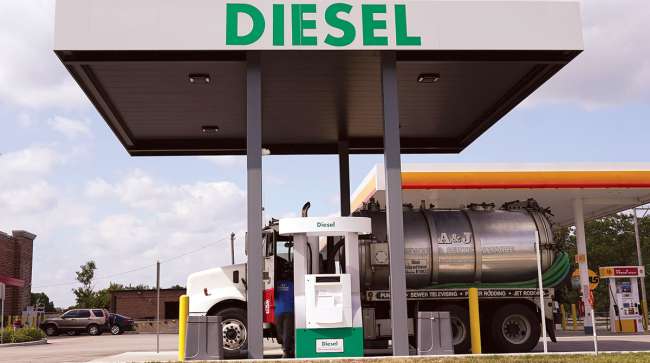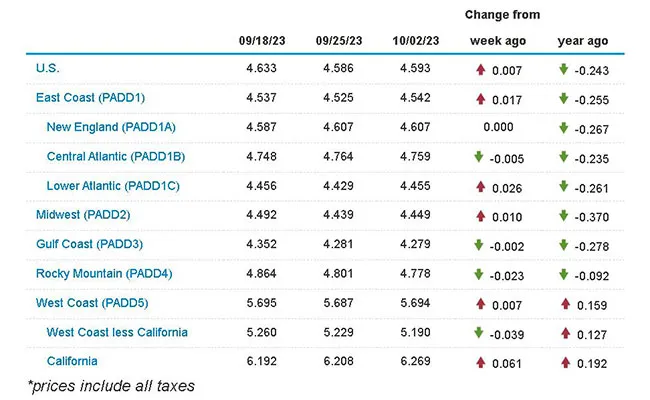Diesel Price Nudges Up 0.7¢ a Gallon to $4.593

[Stay on top of transportation news: Get TTNews in your inbox.]
The national average diesel price nudged up seven-tenths of a cent to reach $4.593 a gallon, according to Energy Information Administration data released Oct. 2.
The modest rise was the 10th increase in the past 11 weeks. The average diesel price dropped 4.7 cents a gallon Sept. 25, but before that, the price had risen a total of 82.7 cents over nine consecutive weeks.
The average price rose in five regions in EIA’s weekly survey, fell in four and was unchanged in New England. The largest increase was 6.1 cents a gallon in California, and the largest decrease was 3.9 cents a gallon in the West Coast less California region.
U.S. On-Highway Diesel Fuel Prices

EIA.gov
Industry players do not expect softer prices any time soon.
“The cards are not lining up in our favor for fuel prices to go anywhere but up,” said Randy Timms, CEO of Western Flyer Express.
Oklahoma City-based Western Flyer Express ranks No. 95 on the Transport Topics Top 100 list of the largest for-hire carriers in North America.
A gallon of diesel now costs 24.3 cents less than it did at this time in 2022. In contrast, at the end of June, the discount to 12 months earlier was in excess of $1.90. “Prices rose so fast that our fuel surcharge could not keep up,” Timms said.
As a result of the jump in fuel prices, conditions have been “brutal” in the spot freight market, Timms said. About 12% of Western Flyer Express’ business is in the spot market, he said.
“There’s no steadiness in the market,” Timms said, noting that business is much more cyclical than ever before.
The national average price for a gallon of gasoline shed 3.9 cents to settle at $3.798, which is 1.6 cents more than it cost at this time a year ago.
U.S. average on-highway #diesel fuel price on October 2, 2023 was $4.593/gallon, UP 0.7¢/gallon from 9/25/23, DOWN 24.3¢/gallon from year ago #truckers #shippers #fuelprices https://t.co/lPvRNZG7iO pic.twitter.com/fiIpe841PF — EIA (@EIAgov) October 3, 2023
U.S. average price for regular-grade #gasoline on October 2, 2023 was $3.798/gal, DOWN 3.9¢/gallon from 9/25/23, UP 1.6¢/gallon from year ago #gasprices https://t.co/jZphFa0Ptd pic.twitter.com/zN1wK8yPEp — EIA (@EIAgov) October 3, 2023
Getting a true read on the market is more difficult than ever before because everything is happening in real time, Timms said, adding that information is available almost too quickly, he said.
On top of this, Timms does not expect freight rates to improve until the middle of 2024. For rates to improve, carriers will need to exit the market, Timms said.
However, domestic demand for diesel remains strong as a result of a more resilient U.S. economy than forecasters and economists expected.
Claudio Irigoyen, Bank of America Securities head of global economics, said Oct. 1 that the resilience of the U.S. economy can be explained by “essentially two factors — a faster-than-expected recovery in business investment and strong private consumption, fueled by a solid household balance and a tight labor market.”
Also, demand from around the globe for U.S. diesel is set to climb in what is already an increasingly tight market.

Shah
Demand from Europe and Latin America is ready to rise, Rystad Energy Senior Downstream Analyst Janiv Shah told TT Oct. 2.
Shah expects U.S. diesel exports to Brazil in particular to increase as a result of a Russian diesel export ban.
Russia banned diesel and gasoline exports to all but four former Soviet Union states midway through September in response to shortages in the country.
Domestically, diesel supplies are already tight. U.S. stocks are about 13% below the five-year average for this time of year, even after rising 400,000 barrels in the week that ended Sept. 22, EIA data show.
American stocks have the potential to decrease further, Shah said. About 2 million barrels per day of refinery capacity is set to go offline for maintenance at various points in the final three months of 2023, he said.
Underlying crude stocks are also tight and are expected to shrink further in the coming months. At 416.3 million barrels, U.S. crude inventories were about 4% below the five-year average through Sept. 22, according to Price Futures Group oil trader Phil Flynn.

Blanch
Bank of America Commodity and Derivatives Strategist Francisco Blanch, meanwhile, expects global oil stocks to decline by 70 million barrels over the next three months, adding support for already firm prices.
“There seems to be no oil rescue on the horizon. The market’s pessimism earlier in the year is now being replaced with supply tightness reality,” Flynn said Oct. 2 in a research note.
Blanch expects the benchmark Brent crude price will average $96 a barrel in the final three months of 2023. That strength means Bank of America expects Brent to average $91 a barrel in the second half of 2023, compared with a prior prognostication of $81 a barrel. Prices were hovering just above $70 a barrel as late as mid-June.
Another factor supporting crude and diesel prices as well as limiting diesel production is how much oil is being drilled.
Benchmark data from oilfield services group Baker Hughes show 623 rigs actively drilling for onshore oil in the U.S. as of Sept. 29, a decrease of seven compared with a week earlier and 142 or 18.6% fewer than 12 months earlier.
There is unlikely to be much help from offshore fields down the line. The Department of the Interior’s auction and leasing program for 2024 through 2029, unveiled Sept. 29, contains a maximum of three potential oil and natural gas lease sales for the Gulf of Mexico — the fewest lease sales since drilling began.
Want more news? Listen to today's daily briefing below or go here for more info:




